Case Study Reflection on DNR Decision-Making in Palliative Care
VerifiedAdded on 2023/06/09
|21
|6333
|250
Case Study
AI Summary
This case study reflection examines a scenario involving a patient, Ahmed, receiving palliative care in a community setting and the subsequent discussion regarding a Do Not Attempt Resuscitation (DNR) order. The reflection highlights the importance of patient-centered care, communication, and addressing cultural and ethical considerations in end-of-life decision-making. It critiques the decision-making process, identifying gaps in assessing the patient's wishes and the conflict arising from differing perspectives between the patient's wife and family. The case study explores the ethical and legal challenges associated with DNR decisions, including patient autonomy, beneficence, and non-maleficence, and emphasizes the need for advanced care planning. It also addresses the role of community nurses and the importance of collaborative practice. The reflection concludes with a call for improved communication and a patient-centered approach to DNR decisions in palliative care to reduce conflicts and ensure transparent care. The case study emphasizes that the decision making process should involve all the stakeholders and patient's family members to make the process more effective and ethical.
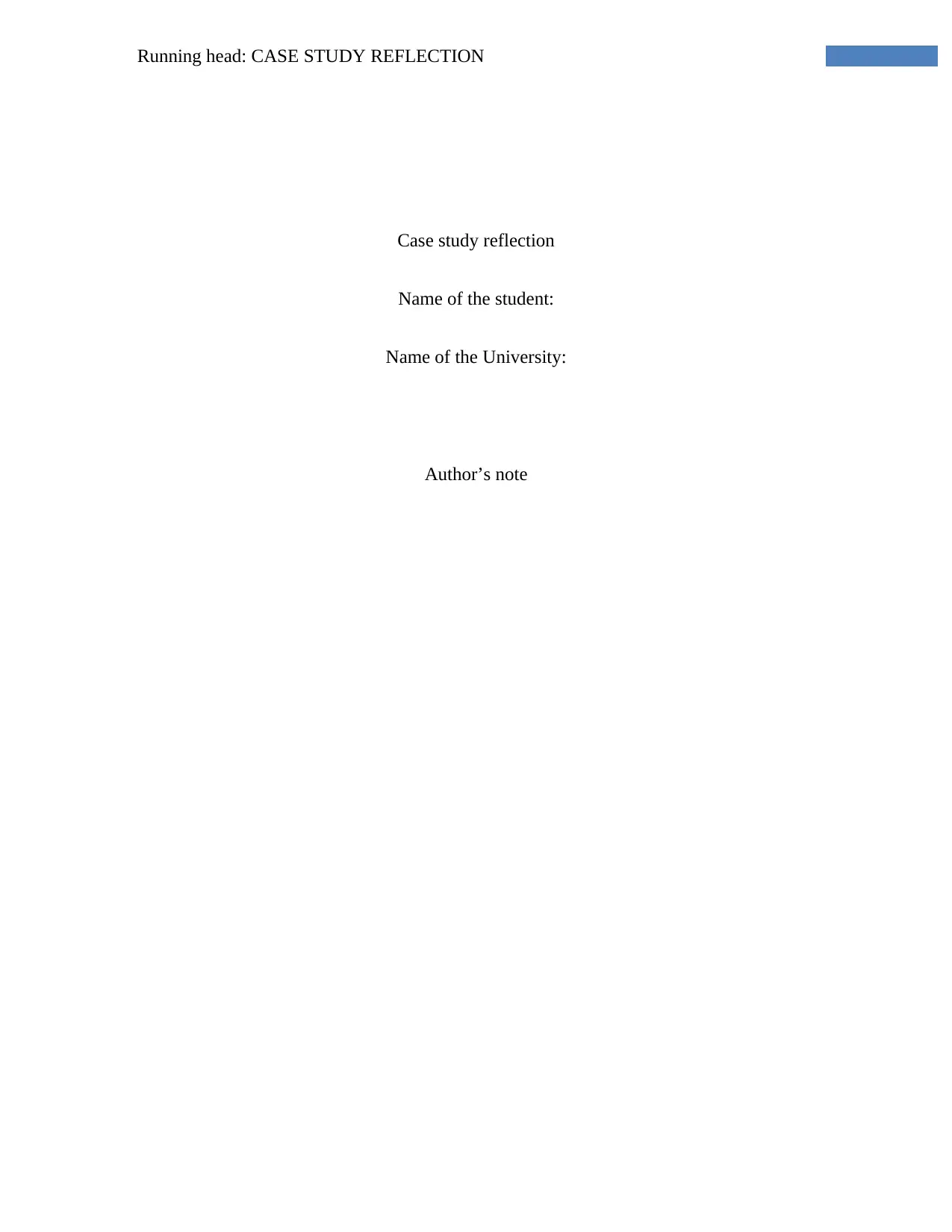
Running head: CASE STUDY REFLECTION
Case study reflection
Name of the student:
Name of the University:
Author’s note
Case study reflection
Name of the student:
Name of the University:
Author’s note
Paraphrase This Document
Need a fresh take? Get an instant paraphrase of this document with our AI Paraphraser
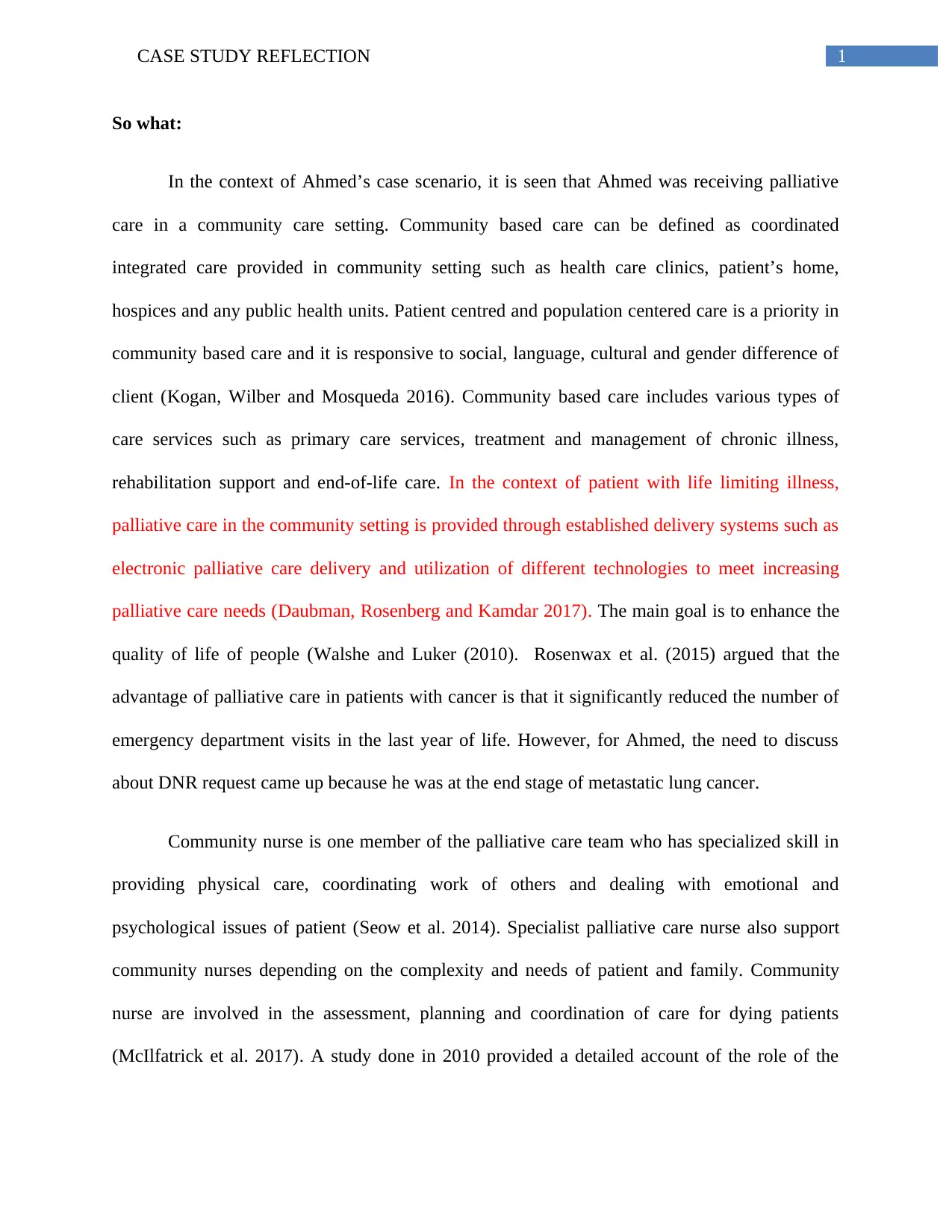
1CASE STUDY REFLECTION
So what:
In the context of Ahmed’s case scenario, it is seen that Ahmed was receiving palliative
care in a community care setting. Community based care can be defined as coordinated
integrated care provided in community setting such as health care clinics, patient’s home,
hospices and any public health units. Patient centred and population centered care is a priority in
community based care and it is responsive to social, language, cultural and gender difference of
client (Kogan, Wilber and Mosqueda 2016). Community based care includes various types of
care services such as primary care services, treatment and management of chronic illness,
rehabilitation support and end-of-life care. In the context of patient with life limiting illness,
palliative care in the community setting is provided through established delivery systems such as
electronic palliative care delivery and utilization of different technologies to meet increasing
palliative care needs (Daubman, Rosenberg and Kamdar 2017). The main goal is to enhance the
quality of life of people (Walshe and Luker (2010). Rosenwax et al. (2015) argued that the
advantage of palliative care in patients with cancer is that it significantly reduced the number of
emergency department visits in the last year of life. However, for Ahmed, the need to discuss
about DNR request came up because he was at the end stage of metastatic lung cancer.
Community nurse is one member of the palliative care team who has specialized skill in
providing physical care, coordinating work of others and dealing with emotional and
psychological issues of patient (Seow et al. 2014). Specialist palliative care nurse also support
community nurses depending on the complexity and needs of patient and family. Community
nurse are involved in the assessment, planning and coordination of care for dying patients
(McIlfatrick et al. 2017). A study done in 2010 provided a detailed account of the role of the
So what:
In the context of Ahmed’s case scenario, it is seen that Ahmed was receiving palliative
care in a community care setting. Community based care can be defined as coordinated
integrated care provided in community setting such as health care clinics, patient’s home,
hospices and any public health units. Patient centred and population centered care is a priority in
community based care and it is responsive to social, language, cultural and gender difference of
client (Kogan, Wilber and Mosqueda 2016). Community based care includes various types of
care services such as primary care services, treatment and management of chronic illness,
rehabilitation support and end-of-life care. In the context of patient with life limiting illness,
palliative care in the community setting is provided through established delivery systems such as
electronic palliative care delivery and utilization of different technologies to meet increasing
palliative care needs (Daubman, Rosenberg and Kamdar 2017). The main goal is to enhance the
quality of life of people (Walshe and Luker (2010). Rosenwax et al. (2015) argued that the
advantage of palliative care in patients with cancer is that it significantly reduced the number of
emergency department visits in the last year of life. However, for Ahmed, the need to discuss
about DNR request came up because he was at the end stage of metastatic lung cancer.
Community nurse is one member of the palliative care team who has specialized skill in
providing physical care, coordinating work of others and dealing with emotional and
psychological issues of patient (Seow et al. 2014). Specialist palliative care nurse also support
community nurses depending on the complexity and needs of patient and family. Community
nurse are involved in the assessment, planning and coordination of care for dying patients
(McIlfatrick et al. 2017). A study done in 2010 provided a detailed account of the role of the
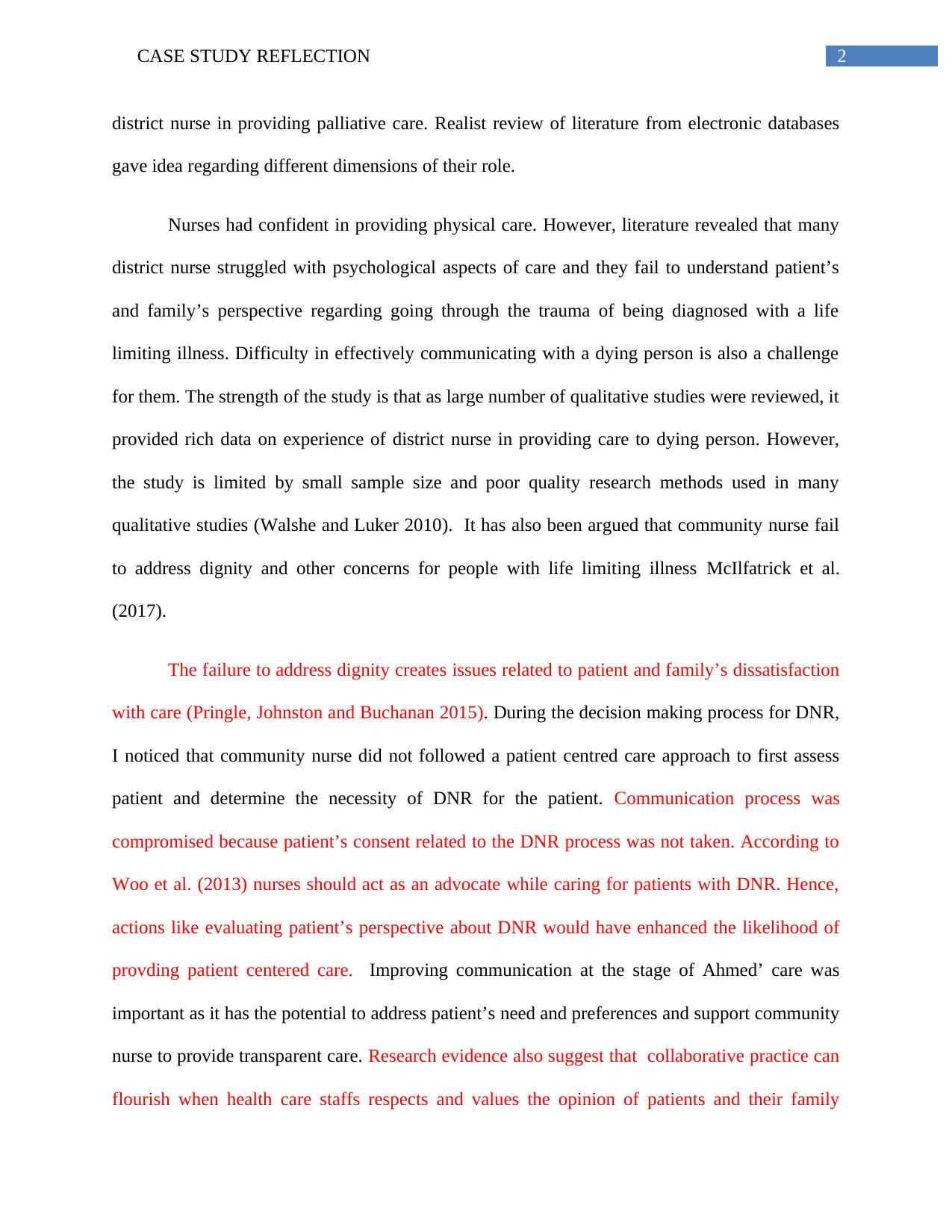
2CASE STUDY REFLECTION
district nurse in providing palliative care. Realist review of literature from electronic databases
gave idea regarding different dimensions of their role.
Nurses had confident in providing physical care. However, literature revealed that many
district nurse struggled with psychological aspects of care and they fail to understand patient’s
and family’s perspective regarding going through the trauma of being diagnosed with a life
limiting illness. Difficulty in effectively communicating with a dying person is also a challenge
for them. The strength of the study is that as large number of qualitative studies were reviewed, it
provided rich data on experience of district nurse in providing care to dying person. However,
the study is limited by small sample size and poor quality research methods used in many
qualitative studies (Walshe and Luker 2010). It has also been argued that community nurse fail
to address dignity and other concerns for people with life limiting illness McIlfatrick et al.
(2017).
The failure to address dignity creates issues related to patient and family’s dissatisfaction
with care (Pringle, Johnston and Buchanan 2015). During the decision making process for DNR,
I noticed that community nurse did not followed a patient centred care approach to first assess
patient and determine the necessity of DNR for the patient. Communication process was
compromised because patient’s consent related to the DNR process was not taken. According to
Woo et al. (2013) nurses should act as an advocate while caring for patients with DNR. Hence,
actions like evaluating patient’s perspective about DNR would have enhanced the likelihood of
provding patient centered care. Improving communication at the stage of Ahmed’ care was
important as it has the potential to address patient’s need and preferences and support community
nurse to provide transparent care. Research evidence also suggest that collaborative practice can
flourish when health care staffs respects and values the opinion of patients and their family
district nurse in providing palliative care. Realist review of literature from electronic databases
gave idea regarding different dimensions of their role.
Nurses had confident in providing physical care. However, literature revealed that many
district nurse struggled with psychological aspects of care and they fail to understand patient’s
and family’s perspective regarding going through the trauma of being diagnosed with a life
limiting illness. Difficulty in effectively communicating with a dying person is also a challenge
for them. The strength of the study is that as large number of qualitative studies were reviewed, it
provided rich data on experience of district nurse in providing care to dying person. However,
the study is limited by small sample size and poor quality research methods used in many
qualitative studies (Walshe and Luker 2010). It has also been argued that community nurse fail
to address dignity and other concerns for people with life limiting illness McIlfatrick et al.
(2017).
The failure to address dignity creates issues related to patient and family’s dissatisfaction
with care (Pringle, Johnston and Buchanan 2015). During the decision making process for DNR,
I noticed that community nurse did not followed a patient centred care approach to first assess
patient and determine the necessity of DNR for the patient. Communication process was
compromised because patient’s consent related to the DNR process was not taken. According to
Woo et al. (2013) nurses should act as an advocate while caring for patients with DNR. Hence,
actions like evaluating patient’s perspective about DNR would have enhanced the likelihood of
provding patient centered care. Improving communication at the stage of Ahmed’ care was
important as it has the potential to address patient’s need and preferences and support community
nurse to provide transparent care. Research evidence also suggest that collaborative practice can
flourish when health care staffs respects and values the opinion of patients and their family
⊘ This is a preview!⊘
Do you want full access?
Subscribe today to unlock all pages.

Trusted by 1+ million students worldwide
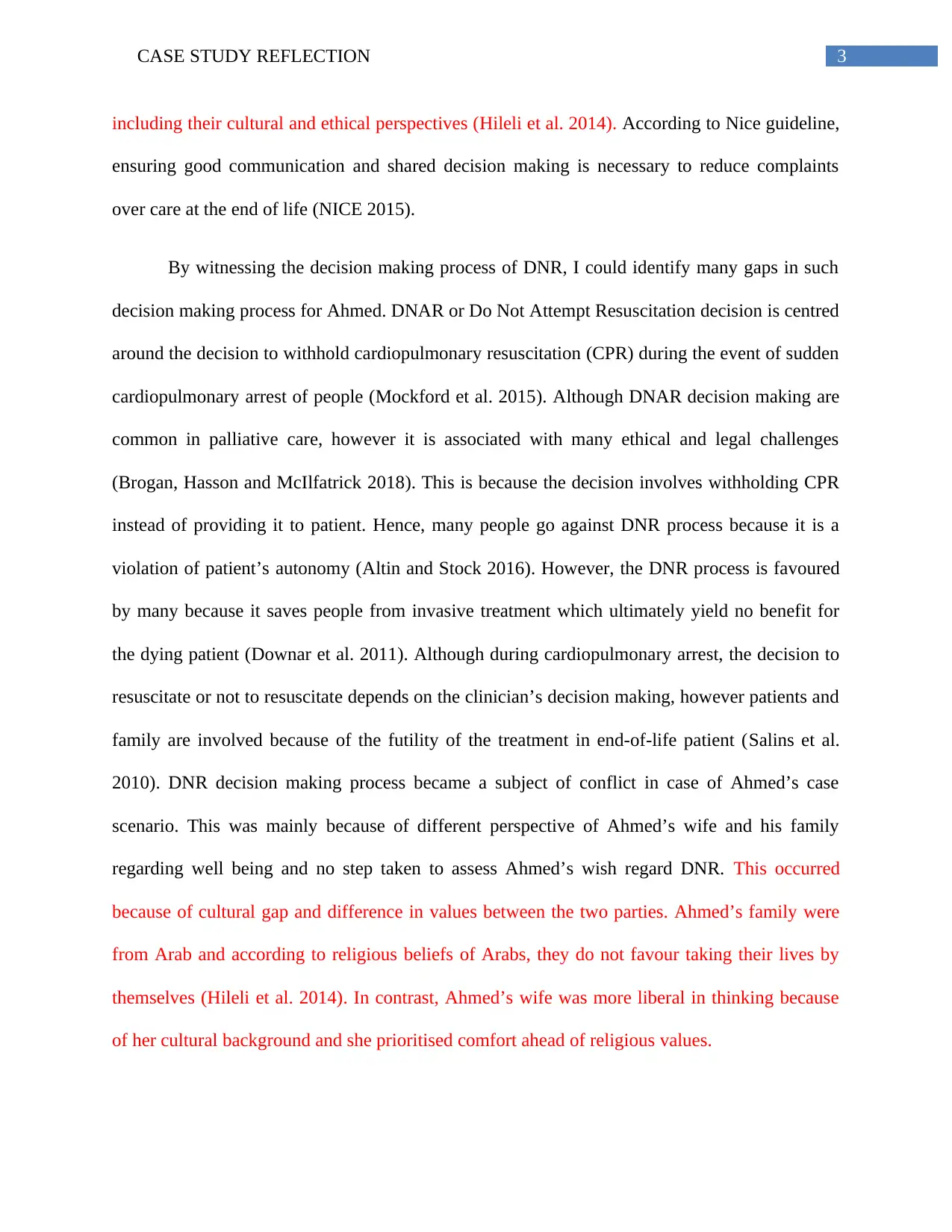
3CASE STUDY REFLECTION
including their cultural and ethical perspectives (Hileli et al. 2014). According to Nice guideline,
ensuring good communication and shared decision making is necessary to reduce complaints
over care at the end of life (NICE 2015).
By witnessing the decision making process of DNR, I could identify many gaps in such
decision making process for Ahmed. DNAR or Do Not Attempt Resuscitation decision is centred
around the decision to withhold cardiopulmonary resuscitation (CPR) during the event of sudden
cardiopulmonary arrest of people (Mockford et al. 2015). Although DNAR decision making are
common in palliative care, however it is associated with many ethical and legal challenges
(Brogan, Hasson and McIlfatrick 2018). This is because the decision involves withholding CPR
instead of providing it to patient. Hence, many people go against DNR process because it is a
violation of patient’s autonomy (Altin and Stock 2016). However, the DNR process is favoured
by many because it saves people from invasive treatment which ultimately yield no benefit for
the dying patient (Downar et al. 2011). Although during cardiopulmonary arrest, the decision to
resuscitate or not to resuscitate depends on the clinician’s decision making, however patients and
family are involved because of the futility of the treatment in end-of-life patient (Salins et al.
2010). DNR decision making process became a subject of conflict in case of Ahmed’s case
scenario. This was mainly because of different perspective of Ahmed’s wife and his family
regarding well being and no step taken to assess Ahmed’s wish regard DNR. This occurred
because of cultural gap and difference in values between the two parties. Ahmed’s family were
from Arab and according to religious beliefs of Arabs, they do not favour taking their lives by
themselves (Hileli et al. 2014). In contrast, Ahmed’s wife was more liberal in thinking because
of her cultural background and she prioritised comfort ahead of religious values.
including their cultural and ethical perspectives (Hileli et al. 2014). According to Nice guideline,
ensuring good communication and shared decision making is necessary to reduce complaints
over care at the end of life (NICE 2015).
By witnessing the decision making process of DNR, I could identify many gaps in such
decision making process for Ahmed. DNAR or Do Not Attempt Resuscitation decision is centred
around the decision to withhold cardiopulmonary resuscitation (CPR) during the event of sudden
cardiopulmonary arrest of people (Mockford et al. 2015). Although DNAR decision making are
common in palliative care, however it is associated with many ethical and legal challenges
(Brogan, Hasson and McIlfatrick 2018). This is because the decision involves withholding CPR
instead of providing it to patient. Hence, many people go against DNR process because it is a
violation of patient’s autonomy (Altin and Stock 2016). However, the DNR process is favoured
by many because it saves people from invasive treatment which ultimately yield no benefit for
the dying patient (Downar et al. 2011). Although during cardiopulmonary arrest, the decision to
resuscitate or not to resuscitate depends on the clinician’s decision making, however patients and
family are involved because of the futility of the treatment in end-of-life patient (Salins et al.
2010). DNR decision making process became a subject of conflict in case of Ahmed’s case
scenario. This was mainly because of different perspective of Ahmed’s wife and his family
regarding well being and no step taken to assess Ahmed’s wish regard DNR. This occurred
because of cultural gap and difference in values between the two parties. Ahmed’s family were
from Arab and according to religious beliefs of Arabs, they do not favour taking their lives by
themselves (Hileli et al. 2014). In contrast, Ahmed’s wife was more liberal in thinking because
of her cultural background and she prioritised comfort ahead of religious values.
Paraphrase This Document
Need a fresh take? Get an instant paraphrase of this document with our AI Paraphraser
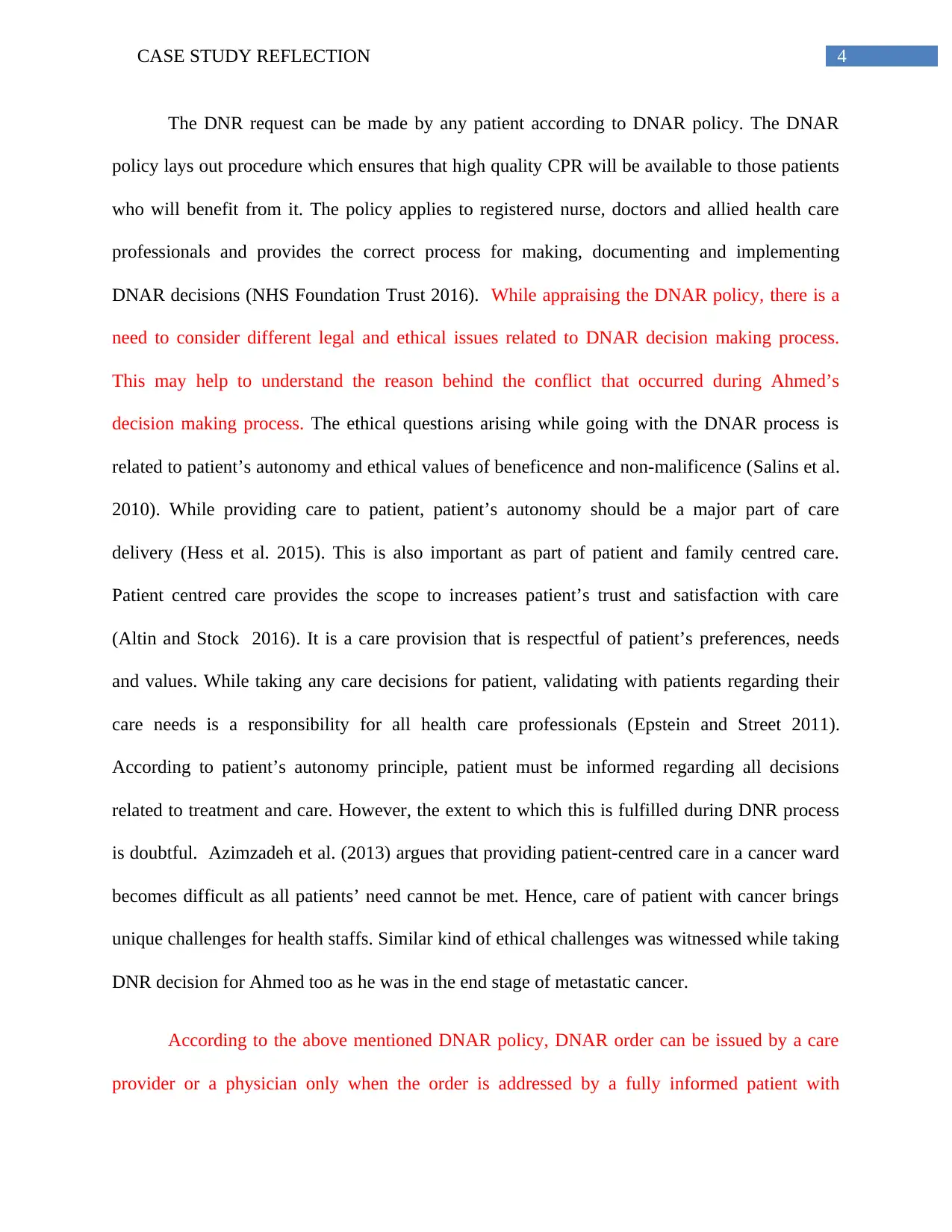
4CASE STUDY REFLECTION
The DNR request can be made by any patient according to DNAR policy. The DNAR
policy lays out procedure which ensures that high quality CPR will be available to those patients
who will benefit from it. The policy applies to registered nurse, doctors and allied health care
professionals and provides the correct process for making, documenting and implementing
DNAR decisions (NHS Foundation Trust 2016). While appraising the DNAR policy, there is a
need to consider different legal and ethical issues related to DNAR decision making process.
This may help to understand the reason behind the conflict that occurred during Ahmed’s
decision making process. The ethical questions arising while going with the DNAR process is
related to patient’s autonomy and ethical values of beneficence and non-malificence (Salins et al.
2010). While providing care to patient, patient’s autonomy should be a major part of care
delivery (Hess et al. 2015). This is also important as part of patient and family centred care.
Patient centred care provides the scope to increases patient’s trust and satisfaction with care
(Altin and Stock 2016). It is a care provision that is respectful of patient’s preferences, needs
and values. While taking any care decisions for patient, validating with patients regarding their
care needs is a responsibility for all health care professionals (Epstein and Street 2011).
According to patient’s autonomy principle, patient must be informed regarding all decisions
related to treatment and care. However, the extent to which this is fulfilled during DNR process
is doubtful. Azimzadeh et al. (2013) argues that providing patient-centred care in a cancer ward
becomes difficult as all patients’ need cannot be met. Hence, care of patient with cancer brings
unique challenges for health staffs. Similar kind of ethical challenges was witnessed while taking
DNR decision for Ahmed too as he was in the end stage of metastatic cancer.
According to the above mentioned DNAR policy, DNAR order can be issued by a care
provider or a physician only when the order is addressed by a fully informed patient with
The DNR request can be made by any patient according to DNAR policy. The DNAR
policy lays out procedure which ensures that high quality CPR will be available to those patients
who will benefit from it. The policy applies to registered nurse, doctors and allied health care
professionals and provides the correct process for making, documenting and implementing
DNAR decisions (NHS Foundation Trust 2016). While appraising the DNAR policy, there is a
need to consider different legal and ethical issues related to DNAR decision making process.
This may help to understand the reason behind the conflict that occurred during Ahmed’s
decision making process. The ethical questions arising while going with the DNAR process is
related to patient’s autonomy and ethical values of beneficence and non-malificence (Salins et al.
2010). While providing care to patient, patient’s autonomy should be a major part of care
delivery (Hess et al. 2015). This is also important as part of patient and family centred care.
Patient centred care provides the scope to increases patient’s trust and satisfaction with care
(Altin and Stock 2016). It is a care provision that is respectful of patient’s preferences, needs
and values. While taking any care decisions for patient, validating with patients regarding their
care needs is a responsibility for all health care professionals (Epstein and Street 2011).
According to patient’s autonomy principle, patient must be informed regarding all decisions
related to treatment and care. However, the extent to which this is fulfilled during DNR process
is doubtful. Azimzadeh et al. (2013) argues that providing patient-centred care in a cancer ward
becomes difficult as all patients’ need cannot be met. Hence, care of patient with cancer brings
unique challenges for health staffs. Similar kind of ethical challenges was witnessed while taking
DNR decision for Ahmed too as he was in the end stage of metastatic cancer.
According to the above mentioned DNAR policy, DNAR order can be issued by a care
provider or a physician only when the order is addressed by a fully informed patient with
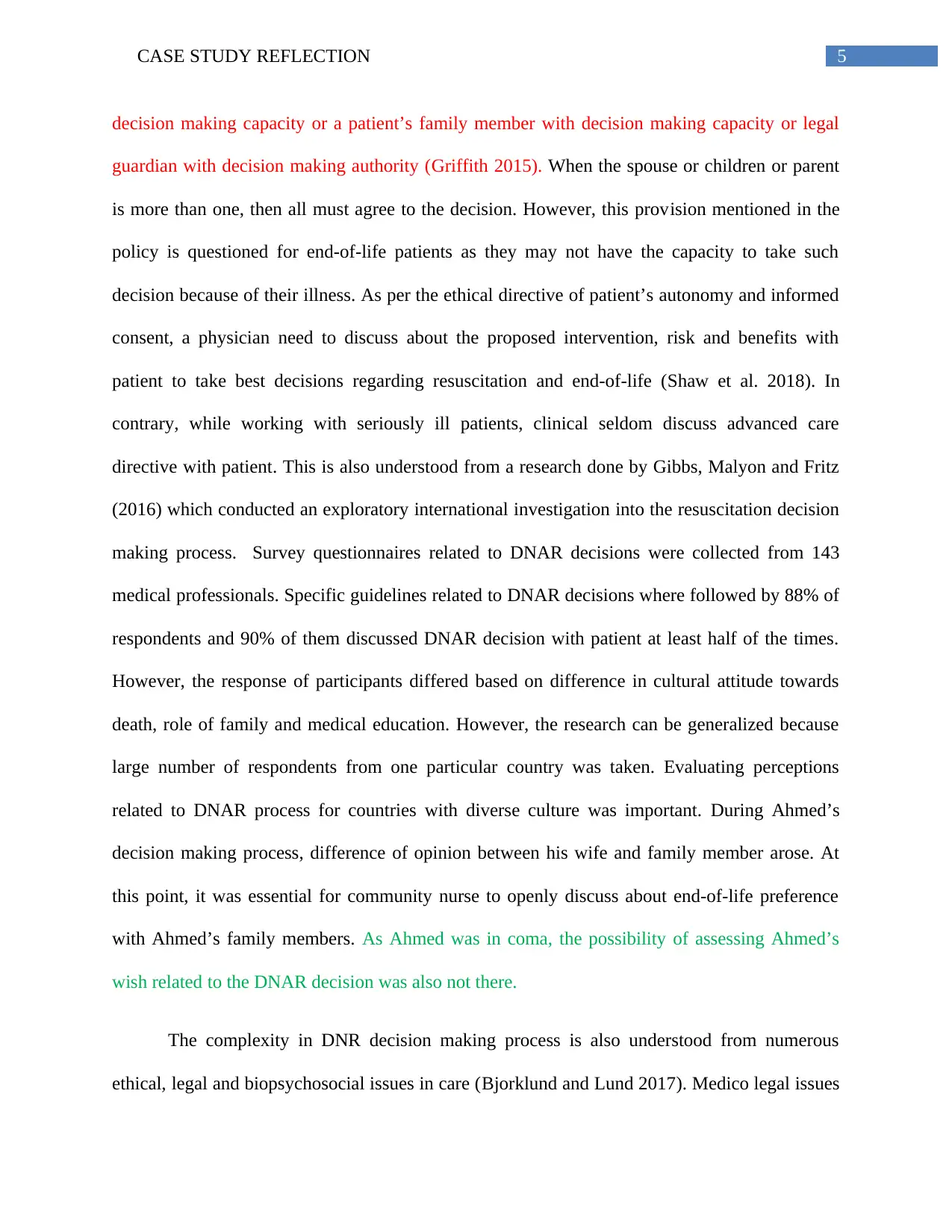
5CASE STUDY REFLECTION
decision making capacity or a patient’s family member with decision making capacity or legal
guardian with decision making authority (Griffith 2015). When the spouse or children or parent
is more than one, then all must agree to the decision. However, this provision mentioned in the
policy is questioned for end-of-life patients as they may not have the capacity to take such
decision because of their illness. As per the ethical directive of patient’s autonomy and informed
consent, a physician need to discuss about the proposed intervention, risk and benefits with
patient to take best decisions regarding resuscitation and end-of-life (Shaw et al. 2018). In
contrary, while working with seriously ill patients, clinical seldom discuss advanced care
directive with patient. This is also understood from a research done by Gibbs, Malyon and Fritz
(2016) which conducted an exploratory international investigation into the resuscitation decision
making process. Survey questionnaires related to DNAR decisions were collected from 143
medical professionals. Specific guidelines related to DNAR decisions where followed by 88% of
respondents and 90% of them discussed DNAR decision with patient at least half of the times.
However, the response of participants differed based on difference in cultural attitude towards
death, role of family and medical education. However, the research can be generalized because
large number of respondents from one particular country was taken. Evaluating perceptions
related to DNAR process for countries with diverse culture was important. During Ahmed’s
decision making process, difference of opinion between his wife and family member arose. At
this point, it was essential for community nurse to openly discuss about end-of-life preference
with Ahmed’s family members. As Ahmed was in coma, the possibility of assessing Ahmed’s
wish related to the DNAR decision was also not there.
The complexity in DNR decision making process is also understood from numerous
ethical, legal and biopsychosocial issues in care (Bjorklund and Lund 2017). Medico legal issues
decision making capacity or a patient’s family member with decision making capacity or legal
guardian with decision making authority (Griffith 2015). When the spouse or children or parent
is more than one, then all must agree to the decision. However, this provision mentioned in the
policy is questioned for end-of-life patients as they may not have the capacity to take such
decision because of their illness. As per the ethical directive of patient’s autonomy and informed
consent, a physician need to discuss about the proposed intervention, risk and benefits with
patient to take best decisions regarding resuscitation and end-of-life (Shaw et al. 2018). In
contrary, while working with seriously ill patients, clinical seldom discuss advanced care
directive with patient. This is also understood from a research done by Gibbs, Malyon and Fritz
(2016) which conducted an exploratory international investigation into the resuscitation decision
making process. Survey questionnaires related to DNAR decisions were collected from 143
medical professionals. Specific guidelines related to DNAR decisions where followed by 88% of
respondents and 90% of them discussed DNAR decision with patient at least half of the times.
However, the response of participants differed based on difference in cultural attitude towards
death, role of family and medical education. However, the research can be generalized because
large number of respondents from one particular country was taken. Evaluating perceptions
related to DNAR process for countries with diverse culture was important. During Ahmed’s
decision making process, difference of opinion between his wife and family member arose. At
this point, it was essential for community nurse to openly discuss about end-of-life preference
with Ahmed’s family members. As Ahmed was in coma, the possibility of assessing Ahmed’s
wish related to the DNAR decision was also not there.
The complexity in DNR decision making process is also understood from numerous
ethical, legal and biopsychosocial issues in care (Bjorklund and Lund 2017). Medico legal issues
⊘ This is a preview!⊘
Do you want full access?
Subscribe today to unlock all pages.

Trusted by 1+ million students worldwide
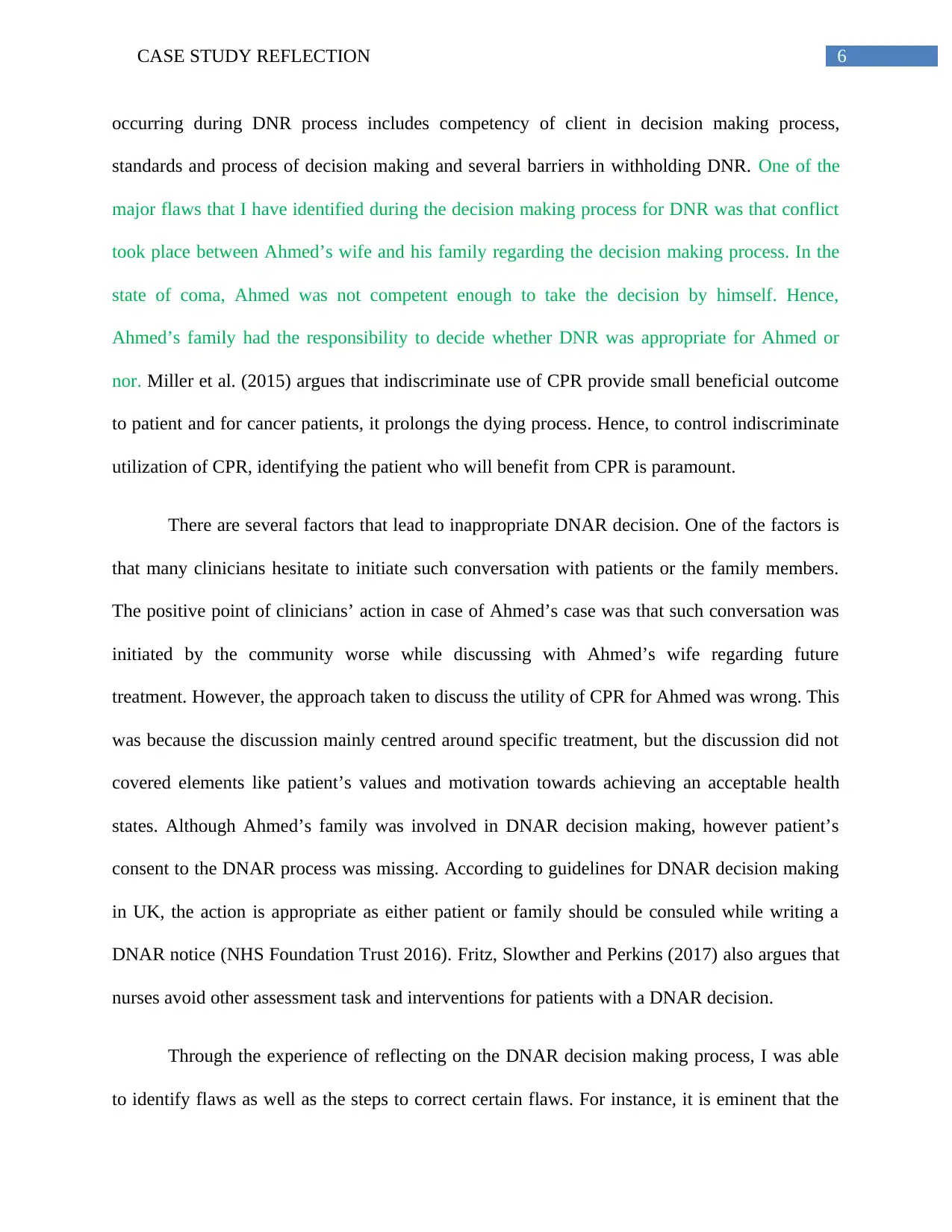
6CASE STUDY REFLECTION
occurring during DNR process includes competency of client in decision making process,
standards and process of decision making and several barriers in withholding DNR. One of the
major flaws that I have identified during the decision making process for DNR was that conflict
took place between Ahmed’s wife and his family regarding the decision making process. In the
state of coma, Ahmed was not competent enough to take the decision by himself. Hence,
Ahmed’s family had the responsibility to decide whether DNR was appropriate for Ahmed or
nor. Miller et al. (2015) argues that indiscriminate use of CPR provide small beneficial outcome
to patient and for cancer patients, it prolongs the dying process. Hence, to control indiscriminate
utilization of CPR, identifying the patient who will benefit from CPR is paramount.
There are several factors that lead to inappropriate DNAR decision. One of the factors is
that many clinicians hesitate to initiate such conversation with patients or the family members.
The positive point of clinicians’ action in case of Ahmed’s case was that such conversation was
initiated by the community worse while discussing with Ahmed’s wife regarding future
treatment. However, the approach taken to discuss the utility of CPR for Ahmed was wrong. This
was because the discussion mainly centred around specific treatment, but the discussion did not
covered elements like patient’s values and motivation towards achieving an acceptable health
states. Although Ahmed’s family was involved in DNAR decision making, however patient’s
consent to the DNAR process was missing. According to guidelines for DNAR decision making
in UK, the action is appropriate as either patient or family should be consuled while writing a
DNAR notice (NHS Foundation Trust 2016). Fritz, Slowther and Perkins (2017) also argues that
nurses avoid other assessment task and interventions for patients with a DNAR decision.
Through the experience of reflecting on the DNAR decision making process, I was able
to identify flaws as well as the steps to correct certain flaws. For instance, it is eminent that the
occurring during DNR process includes competency of client in decision making process,
standards and process of decision making and several barriers in withholding DNR. One of the
major flaws that I have identified during the decision making process for DNR was that conflict
took place between Ahmed’s wife and his family regarding the decision making process. In the
state of coma, Ahmed was not competent enough to take the decision by himself. Hence,
Ahmed’s family had the responsibility to decide whether DNR was appropriate for Ahmed or
nor. Miller et al. (2015) argues that indiscriminate use of CPR provide small beneficial outcome
to patient and for cancer patients, it prolongs the dying process. Hence, to control indiscriminate
utilization of CPR, identifying the patient who will benefit from CPR is paramount.
There are several factors that lead to inappropriate DNAR decision. One of the factors is
that many clinicians hesitate to initiate such conversation with patients or the family members.
The positive point of clinicians’ action in case of Ahmed’s case was that such conversation was
initiated by the community worse while discussing with Ahmed’s wife regarding future
treatment. However, the approach taken to discuss the utility of CPR for Ahmed was wrong. This
was because the discussion mainly centred around specific treatment, but the discussion did not
covered elements like patient’s values and motivation towards achieving an acceptable health
states. Although Ahmed’s family was involved in DNAR decision making, however patient’s
consent to the DNAR process was missing. According to guidelines for DNAR decision making
in UK, the action is appropriate as either patient or family should be consuled while writing a
DNAR notice (NHS Foundation Trust 2016). Fritz, Slowther and Perkins (2017) also argues that
nurses avoid other assessment task and interventions for patients with a DNAR decision.
Through the experience of reflecting on the DNAR decision making process, I was able
to identify flaws as well as the steps to correct certain flaws. For instance, it is eminent that the
Paraphrase This Document
Need a fresh take? Get an instant paraphrase of this document with our AI Paraphraser
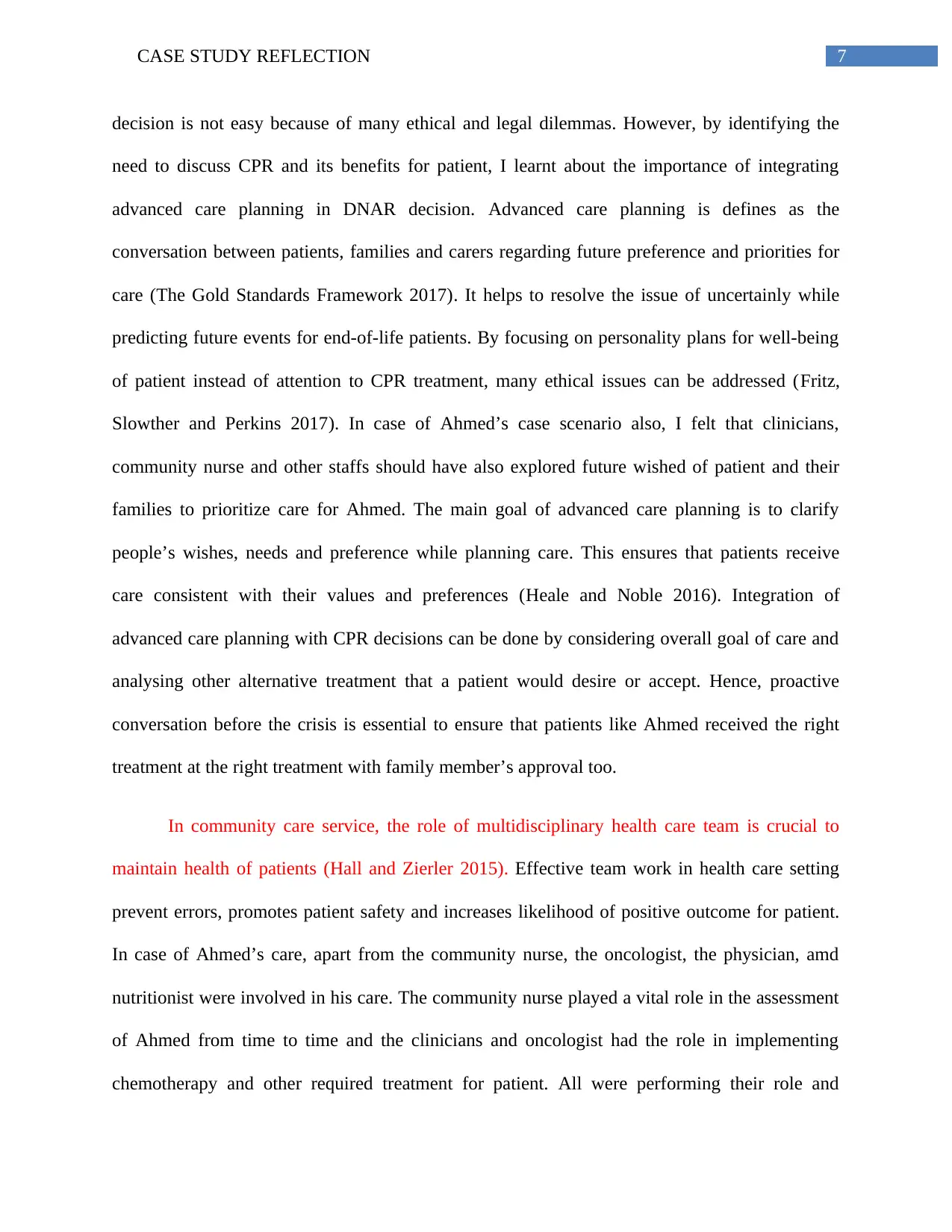
7CASE STUDY REFLECTION
decision is not easy because of many ethical and legal dilemmas. However, by identifying the
need to discuss CPR and its benefits for patient, I learnt about the importance of integrating
advanced care planning in DNAR decision. Advanced care planning is defines as the
conversation between patients, families and carers regarding future preference and priorities for
care (The Gold Standards Framework 2017). It helps to resolve the issue of uncertainly while
predicting future events for end-of-life patients. By focusing on personality plans for well-being
of patient instead of attention to CPR treatment, many ethical issues can be addressed (Fritz,
Slowther and Perkins 2017). In case of Ahmed’s case scenario also, I felt that clinicians,
community nurse and other staffs should have also explored future wished of patient and their
families to prioritize care for Ahmed. The main goal of advanced care planning is to clarify
people’s wishes, needs and preference while planning care. This ensures that patients receive
care consistent with their values and preferences (Heale and Noble 2016). Integration of
advanced care planning with CPR decisions can be done by considering overall goal of care and
analysing other alternative treatment that a patient would desire or accept. Hence, proactive
conversation before the crisis is essential to ensure that patients like Ahmed received the right
treatment at the right treatment with family member’s approval too.
In community care service, the role of multidisciplinary health care team is crucial to
maintain health of patients (Hall and Zierler 2015). Effective team work in health care setting
prevent errors, promotes patient safety and increases likelihood of positive outcome for patient.
In case of Ahmed’s care, apart from the community nurse, the oncologist, the physician, amd
nutritionist were involved in his care. The community nurse played a vital role in the assessment
of Ahmed from time to time and the clinicians and oncologist had the role in implementing
chemotherapy and other required treatment for patient. All were performing their role and
decision is not easy because of many ethical and legal dilemmas. However, by identifying the
need to discuss CPR and its benefits for patient, I learnt about the importance of integrating
advanced care planning in DNAR decision. Advanced care planning is defines as the
conversation between patients, families and carers regarding future preference and priorities for
care (The Gold Standards Framework 2017). It helps to resolve the issue of uncertainly while
predicting future events for end-of-life patients. By focusing on personality plans for well-being
of patient instead of attention to CPR treatment, many ethical issues can be addressed (Fritz,
Slowther and Perkins 2017). In case of Ahmed’s case scenario also, I felt that clinicians,
community nurse and other staffs should have also explored future wished of patient and their
families to prioritize care for Ahmed. The main goal of advanced care planning is to clarify
people’s wishes, needs and preference while planning care. This ensures that patients receive
care consistent with their values and preferences (Heale and Noble 2016). Integration of
advanced care planning with CPR decisions can be done by considering overall goal of care and
analysing other alternative treatment that a patient would desire or accept. Hence, proactive
conversation before the crisis is essential to ensure that patients like Ahmed received the right
treatment at the right treatment with family member’s approval too.
In community care service, the role of multidisciplinary health care team is crucial to
maintain health of patients (Hall and Zierler 2015). Effective team work in health care setting
prevent errors, promotes patient safety and increases likelihood of positive outcome for patient.
In case of Ahmed’s care, apart from the community nurse, the oncologist, the physician, amd
nutritionist were involved in his care. The community nurse played a vital role in the assessment
of Ahmed from time to time and the clinicians and oncologist had the role in implementing
chemotherapy and other required treatment for patient. All were performing their role and
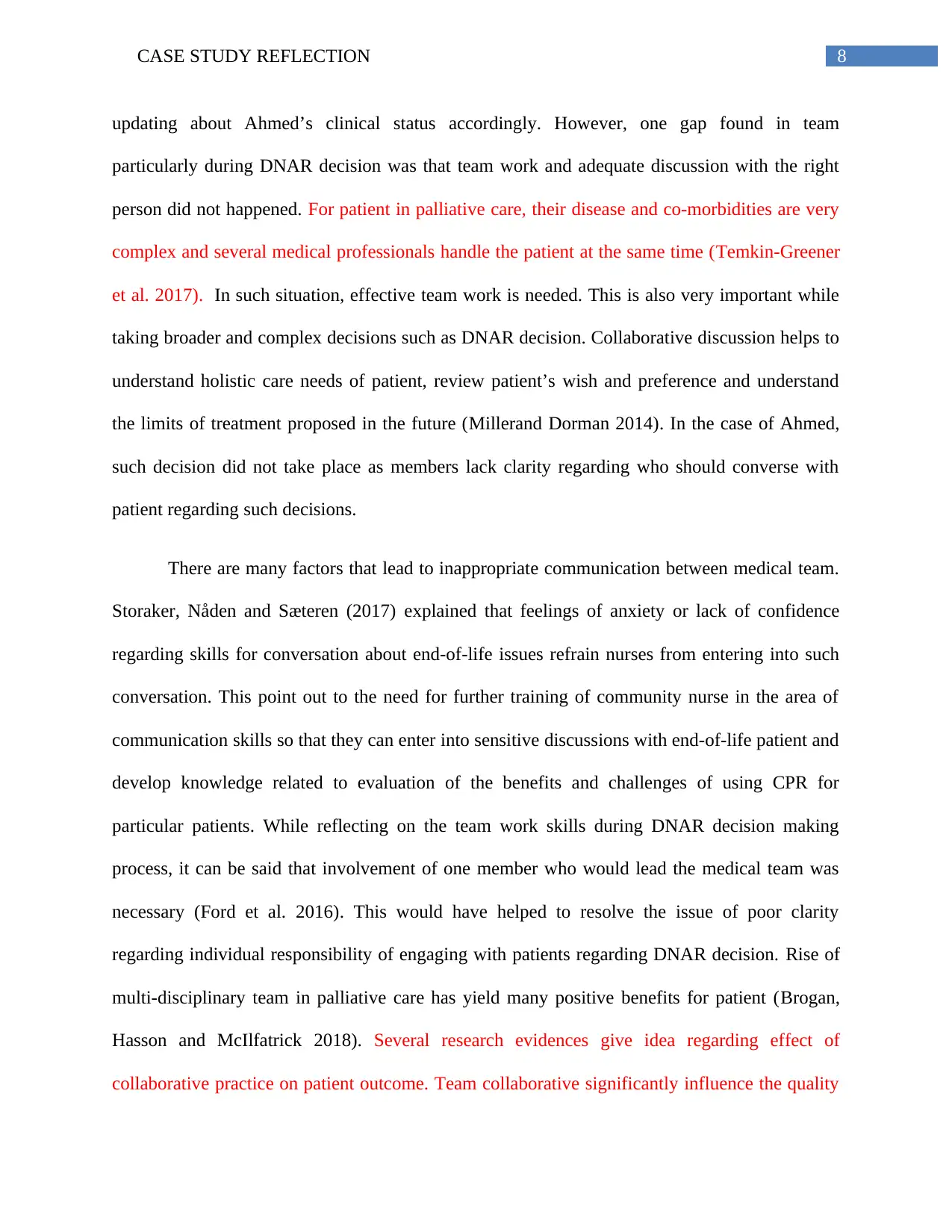
8CASE STUDY REFLECTION
updating about Ahmed’s clinical status accordingly. However, one gap found in team
particularly during DNAR decision was that team work and adequate discussion with the right
person did not happened. For patient in palliative care, their disease and co-morbidities are very
complex and several medical professionals handle the patient at the same time (Temkin-Greener
et al. 2017). In such situation, effective team work is needed. This is also very important while
taking broader and complex decisions such as DNAR decision. Collaborative discussion helps to
understand holistic care needs of patient, review patient’s wish and preference and understand
the limits of treatment proposed in the future (Millerand Dorman 2014). In the case of Ahmed,
such decision did not take place as members lack clarity regarding who should converse with
patient regarding such decisions.
There are many factors that lead to inappropriate communication between medical team.
Storaker, Nåden and Sæteren (2017) explained that feelings of anxiety or lack of confidence
regarding skills for conversation about end-of-life issues refrain nurses from entering into such
conversation. This point out to the need for further training of community nurse in the area of
communication skills so that they can enter into sensitive discussions with end-of-life patient and
develop knowledge related to evaluation of the benefits and challenges of using CPR for
particular patients. While reflecting on the team work skills during DNAR decision making
process, it can be said that involvement of one member who would lead the medical team was
necessary (Ford et al. 2016). This would have helped to resolve the issue of poor clarity
regarding individual responsibility of engaging with patients regarding DNAR decision. Rise of
multi-disciplinary team in palliative care has yield many positive benefits for patient (Brogan,
Hasson and McIlfatrick 2018). Several research evidences give idea regarding effect of
collaborative practice on patient outcome. Team collaborative significantly influence the quality
updating about Ahmed’s clinical status accordingly. However, one gap found in team
particularly during DNAR decision was that team work and adequate discussion with the right
person did not happened. For patient in palliative care, their disease and co-morbidities are very
complex and several medical professionals handle the patient at the same time (Temkin-Greener
et al. 2017). In such situation, effective team work is needed. This is also very important while
taking broader and complex decisions such as DNAR decision. Collaborative discussion helps to
understand holistic care needs of patient, review patient’s wish and preference and understand
the limits of treatment proposed in the future (Millerand Dorman 2014). In the case of Ahmed,
such decision did not take place as members lack clarity regarding who should converse with
patient regarding such decisions.
There are many factors that lead to inappropriate communication between medical team.
Storaker, Nåden and Sæteren (2017) explained that feelings of anxiety or lack of confidence
regarding skills for conversation about end-of-life issues refrain nurses from entering into such
conversation. This point out to the need for further training of community nurse in the area of
communication skills so that they can enter into sensitive discussions with end-of-life patient and
develop knowledge related to evaluation of the benefits and challenges of using CPR for
particular patients. While reflecting on the team work skills during DNAR decision making
process, it can be said that involvement of one member who would lead the medical team was
necessary (Ford et al. 2016). This would have helped to resolve the issue of poor clarity
regarding individual responsibility of engaging with patients regarding DNAR decision. Rise of
multi-disciplinary team in palliative care has yield many positive benefits for patient (Brogan,
Hasson and McIlfatrick 2018). Several research evidences give idea regarding effect of
collaborative practice on patient outcome. Team collaborative significantly influence the quality
⊘ This is a preview!⊘
Do you want full access?
Subscribe today to unlock all pages.

Trusted by 1+ million students worldwide
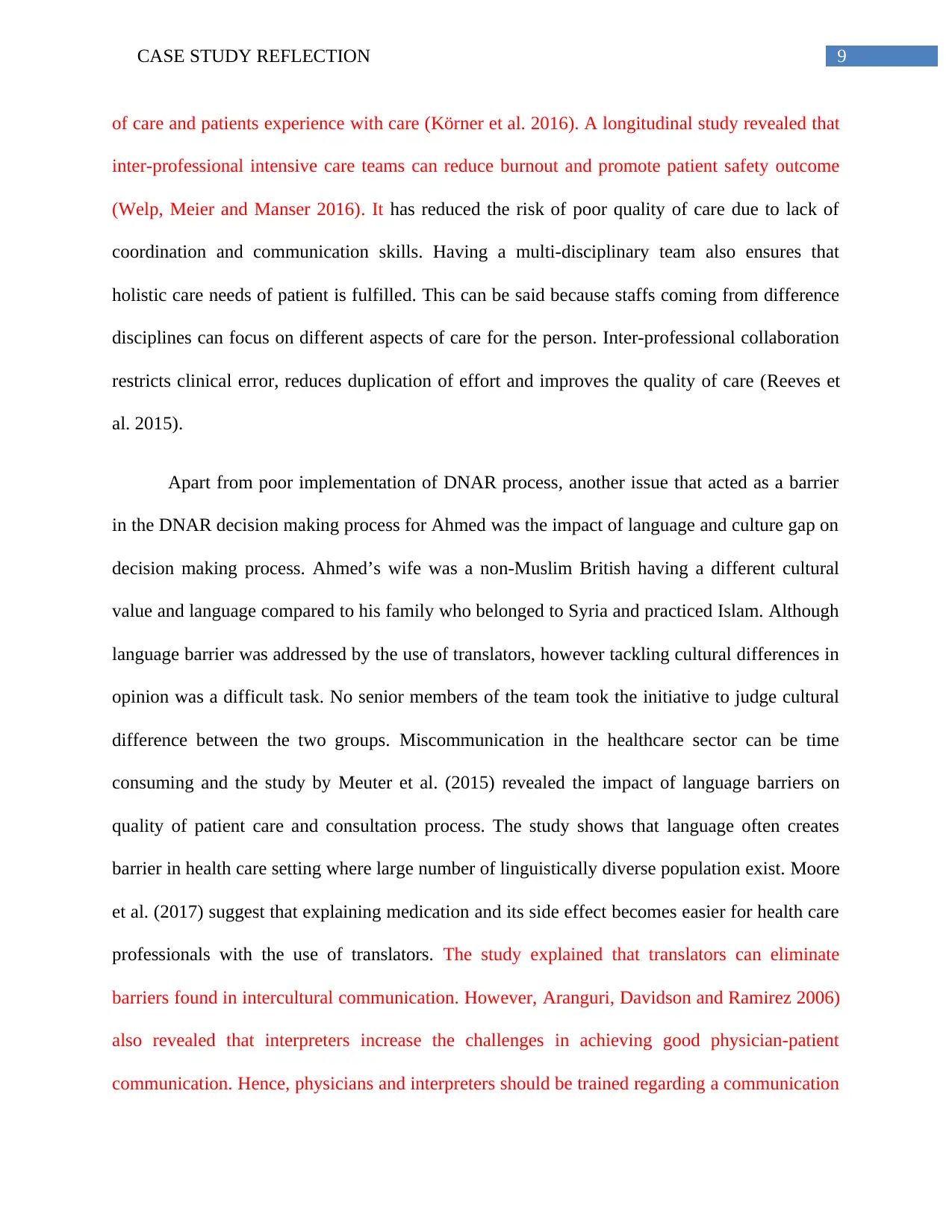
9CASE STUDY REFLECTION
of care and patients experience with care (Körner et al. 2016). A longitudinal study revealed that
inter-professional intensive care teams can reduce burnout and promote patient safety outcome
(Welp, Meier and Manser 2016). It has reduced the risk of poor quality of care due to lack of
coordination and communication skills. Having a multi-disciplinary team also ensures that
holistic care needs of patient is fulfilled. This can be said because staffs coming from difference
disciplines can focus on different aspects of care for the person. Inter-professional collaboration
restricts clinical error, reduces duplication of effort and improves the quality of care (Reeves et
al. 2015).
Apart from poor implementation of DNAR process, another issue that acted as a barrier
in the DNAR decision making process for Ahmed was the impact of language and culture gap on
decision making process. Ahmed’s wife was a non-Muslim British having a different cultural
value and language compared to his family who belonged to Syria and practiced Islam. Although
language barrier was addressed by the use of translators, however tackling cultural differences in
opinion was a difficult task. No senior members of the team took the initiative to judge cultural
difference between the two groups. Miscommunication in the healthcare sector can be time
consuming and the study by Meuter et al. (2015) revealed the impact of language barriers on
quality of patient care and consultation process. The study shows that language often creates
barrier in health care setting where large number of linguistically diverse population exist. Moore
et al. (2017) suggest that explaining medication and its side effect becomes easier for health care
professionals with the use of translators. The study explained that translators can eliminate
barriers found in intercultural communication. However, Aranguri, Davidson and Ramirez 2006)
also revealed that interpreters increase the challenges in achieving good physician-patient
communication. Hence, physicians and interpreters should be trained regarding a communication
of care and patients experience with care (Körner et al. 2016). A longitudinal study revealed that
inter-professional intensive care teams can reduce burnout and promote patient safety outcome
(Welp, Meier and Manser 2016). It has reduced the risk of poor quality of care due to lack of
coordination and communication skills. Having a multi-disciplinary team also ensures that
holistic care needs of patient is fulfilled. This can be said because staffs coming from difference
disciplines can focus on different aspects of care for the person. Inter-professional collaboration
restricts clinical error, reduces duplication of effort and improves the quality of care (Reeves et
al. 2015).
Apart from poor implementation of DNAR process, another issue that acted as a barrier
in the DNAR decision making process for Ahmed was the impact of language and culture gap on
decision making process. Ahmed’s wife was a non-Muslim British having a different cultural
value and language compared to his family who belonged to Syria and practiced Islam. Although
language barrier was addressed by the use of translators, however tackling cultural differences in
opinion was a difficult task. No senior members of the team took the initiative to judge cultural
difference between the two groups. Miscommunication in the healthcare sector can be time
consuming and the study by Meuter et al. (2015) revealed the impact of language barriers on
quality of patient care and consultation process. The study shows that language often creates
barrier in health care setting where large number of linguistically diverse population exist. Moore
et al. (2017) suggest that explaining medication and its side effect becomes easier for health care
professionals with the use of translators. The study explained that translators can eliminate
barriers found in intercultural communication. However, Aranguri, Davidson and Ramirez 2006)
also revealed that interpreters increase the challenges in achieving good physician-patient
communication. Hence, physicians and interpreters should be trained regarding a communication
Paraphrase This Document
Need a fresh take? Get an instant paraphrase of this document with our AI Paraphraser
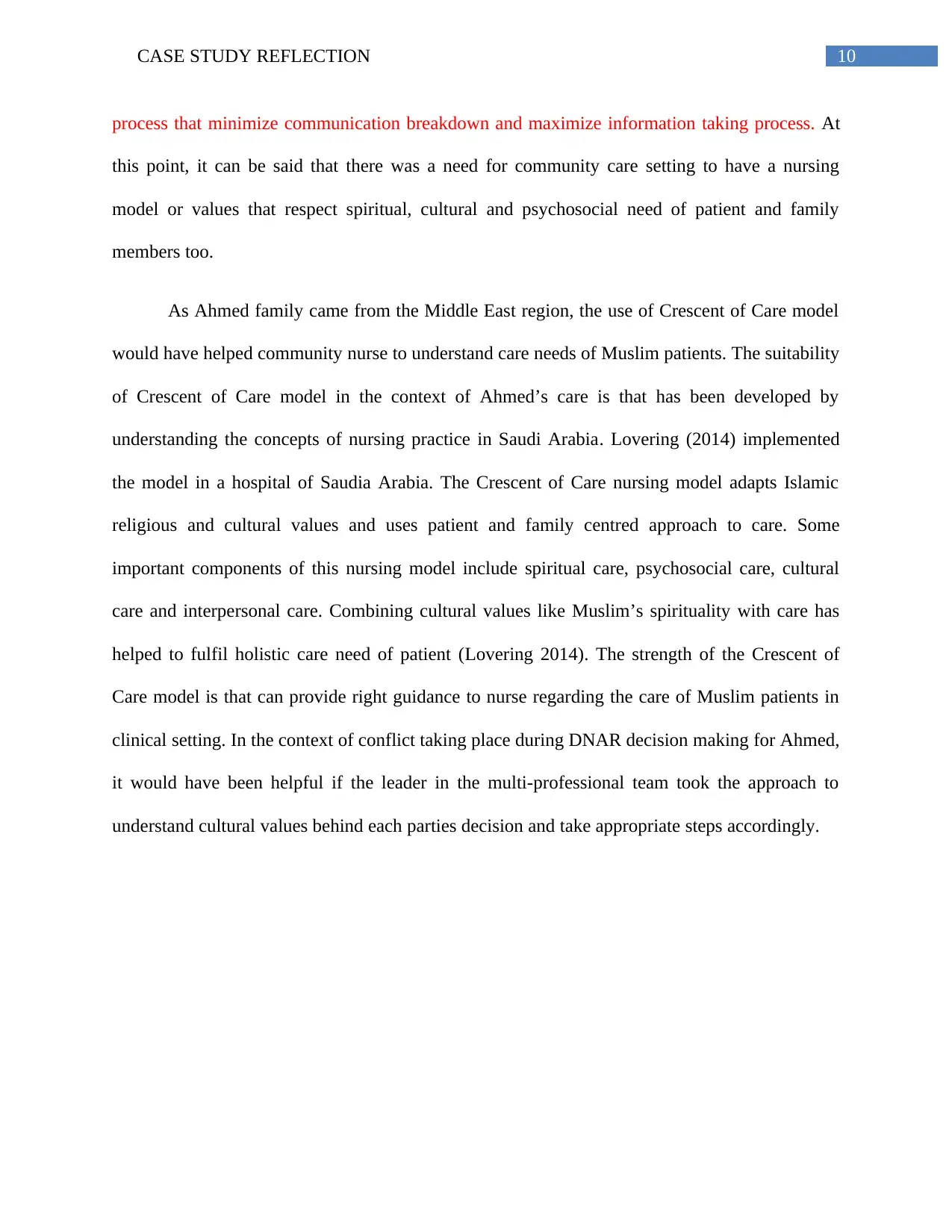
10CASE STUDY REFLECTION
process that minimize communication breakdown and maximize information taking process. At
this point, it can be said that there was a need for community care setting to have a nursing
model or values that respect spiritual, cultural and psychosocial need of patient and family
members too.
As Ahmed family came from the Middle East region, the use of Crescent of Care model
would have helped community nurse to understand care needs of Muslim patients. The suitability
of Crescent of Care model in the context of Ahmed’s care is that has been developed by
understanding the concepts of nursing practice in Saudi Arabia. Lovering (2014) implemented
the model in a hospital of Saudia Arabia. The Crescent of Care nursing model adapts Islamic
religious and cultural values and uses patient and family centred approach to care. Some
important components of this nursing model include spiritual care, psychosocial care, cultural
care and interpersonal care. Combining cultural values like Muslim’s spirituality with care has
helped to fulfil holistic care need of patient (Lovering 2014). The strength of the Crescent of
Care model is that can provide right guidance to nurse regarding the care of Muslim patients in
clinical setting. In the context of conflict taking place during DNAR decision making for Ahmed,
it would have been helpful if the leader in the multi-professional team took the approach to
understand cultural values behind each parties decision and take appropriate steps accordingly.
process that minimize communication breakdown and maximize information taking process. At
this point, it can be said that there was a need for community care setting to have a nursing
model or values that respect spiritual, cultural and psychosocial need of patient and family
members too.
As Ahmed family came from the Middle East region, the use of Crescent of Care model
would have helped community nurse to understand care needs of Muslim patients. The suitability
of Crescent of Care model in the context of Ahmed’s care is that has been developed by
understanding the concepts of nursing practice in Saudi Arabia. Lovering (2014) implemented
the model in a hospital of Saudia Arabia. The Crescent of Care nursing model adapts Islamic
religious and cultural values and uses patient and family centred approach to care. Some
important components of this nursing model include spiritual care, psychosocial care, cultural
care and interpersonal care. Combining cultural values like Muslim’s spirituality with care has
helped to fulfil holistic care need of patient (Lovering 2014). The strength of the Crescent of
Care model is that can provide right guidance to nurse regarding the care of Muslim patients in
clinical setting. In the context of conflict taking place during DNAR decision making for Ahmed,
it would have been helpful if the leader in the multi-professional team took the approach to
understand cultural values behind each parties decision and take appropriate steps accordingly.
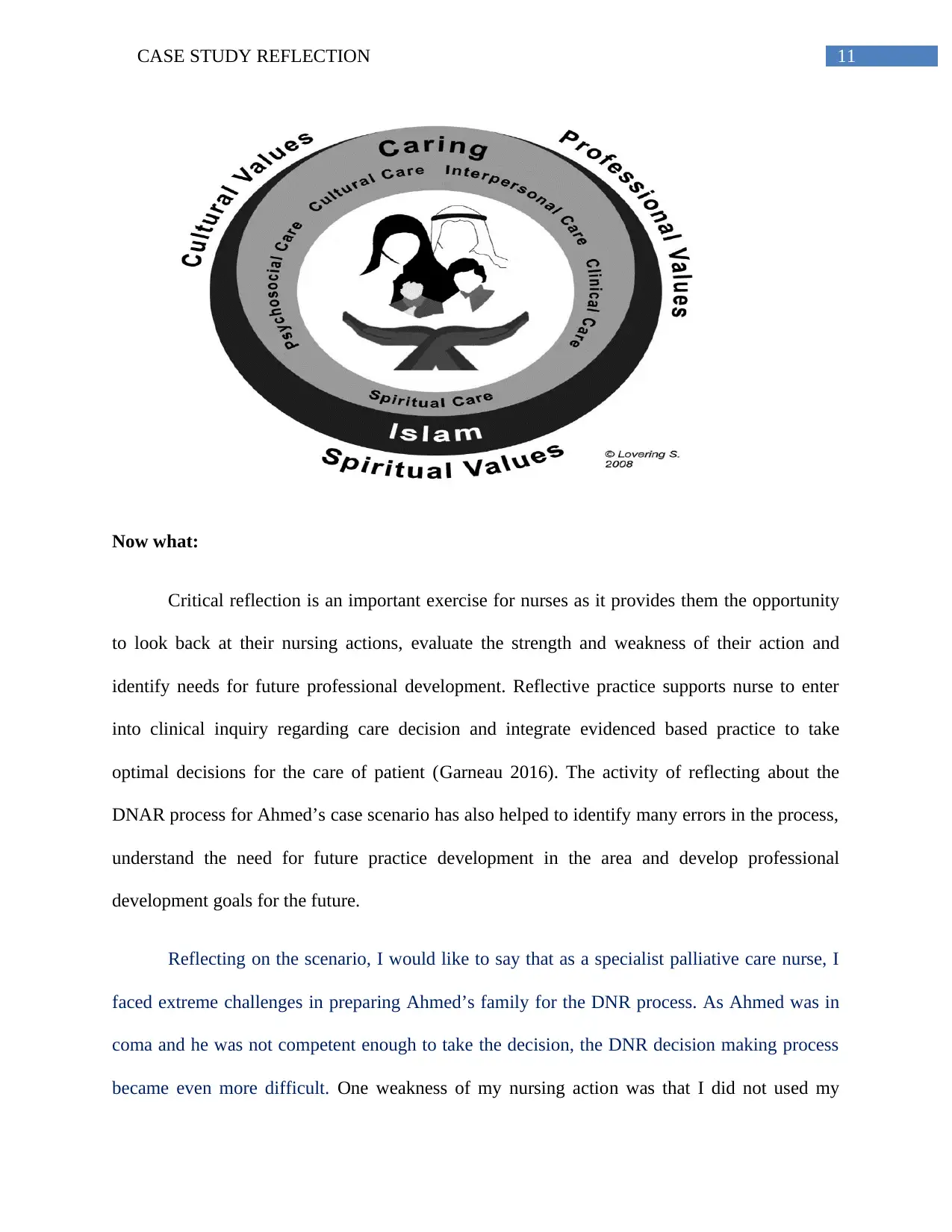
11CASE STUDY REFLECTION
Now what:
Critical reflection is an important exercise for nurses as it provides them the opportunity
to look back at their nursing actions, evaluate the strength and weakness of their action and
identify needs for future professional development. Reflective practice supports nurse to enter
into clinical inquiry regarding care decision and integrate evidenced based practice to take
optimal decisions for the care of patient (Garneau 2016). The activity of reflecting about the
DNAR process for Ahmed’s case scenario has also helped to identify many errors in the process,
understand the need for future practice development in the area and develop professional
development goals for the future.
Reflecting on the scenario, I would like to say that as a specialist palliative care nurse, I
faced extreme challenges in preparing Ahmed’s family for the DNR process. As Ahmed was in
coma and he was not competent enough to take the decision, the DNR decision making process
became even more difficult. One weakness of my nursing action was that I did not used my
Now what:
Critical reflection is an important exercise for nurses as it provides them the opportunity
to look back at their nursing actions, evaluate the strength and weakness of their action and
identify needs for future professional development. Reflective practice supports nurse to enter
into clinical inquiry regarding care decision and integrate evidenced based practice to take
optimal decisions for the care of patient (Garneau 2016). The activity of reflecting about the
DNAR process for Ahmed’s case scenario has also helped to identify many errors in the process,
understand the need for future practice development in the area and develop professional
development goals for the future.
Reflecting on the scenario, I would like to say that as a specialist palliative care nurse, I
faced extreme challenges in preparing Ahmed’s family for the DNR process. As Ahmed was in
coma and he was not competent enough to take the decision, the DNR decision making process
became even more difficult. One weakness of my nursing action was that I did not used my
⊘ This is a preview!⊘
Do you want full access?
Subscribe today to unlock all pages.

Trusted by 1+ million students worldwide
1 out of 21
Related Documents
Your All-in-One AI-Powered Toolkit for Academic Success.
+13062052269
info@desklib.com
Available 24*7 on WhatsApp / Email
![[object Object]](/_next/static/media/star-bottom.7253800d.svg)
Unlock your academic potential
Copyright © 2020–2025 A2Z Services. All Rights Reserved. Developed and managed by ZUCOL.





